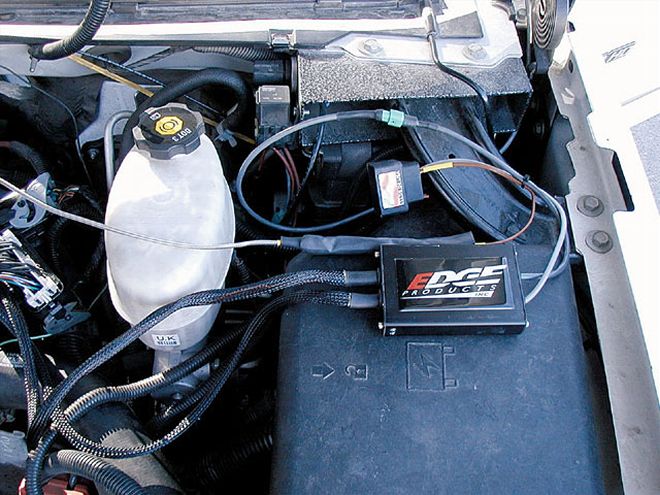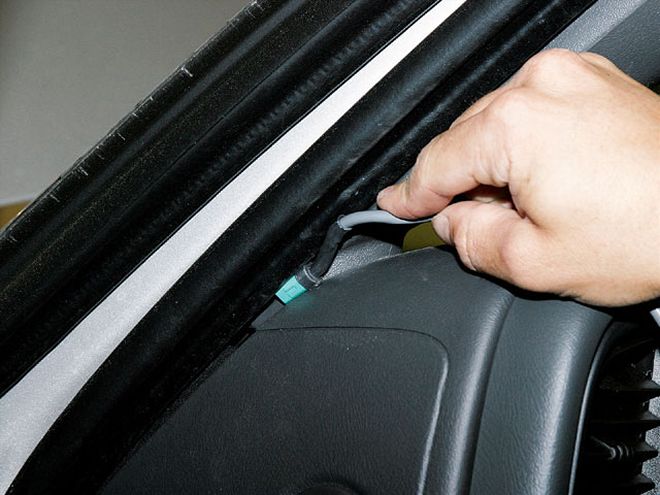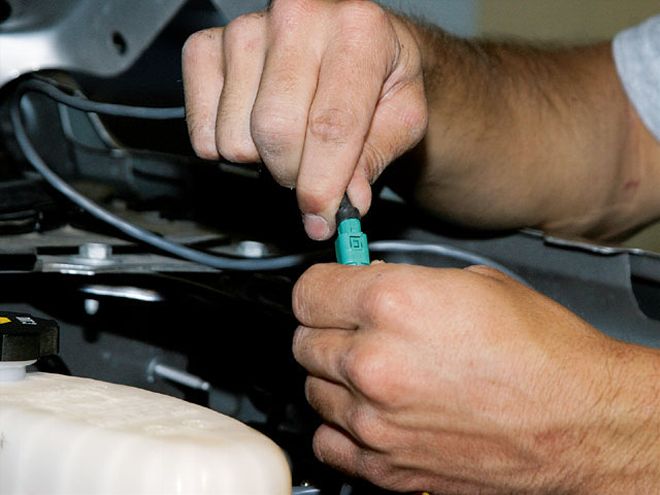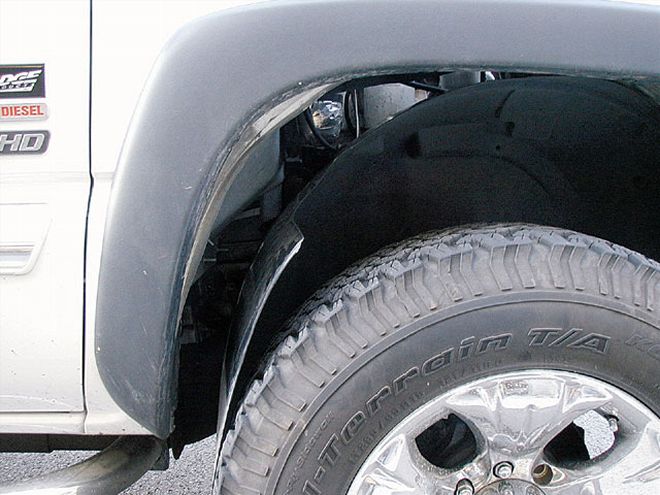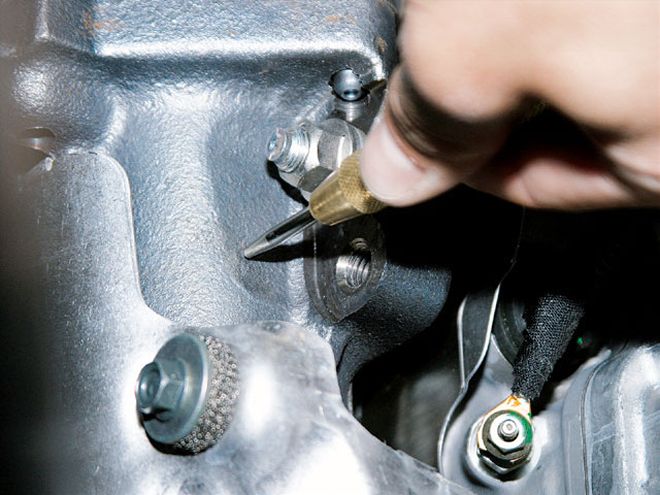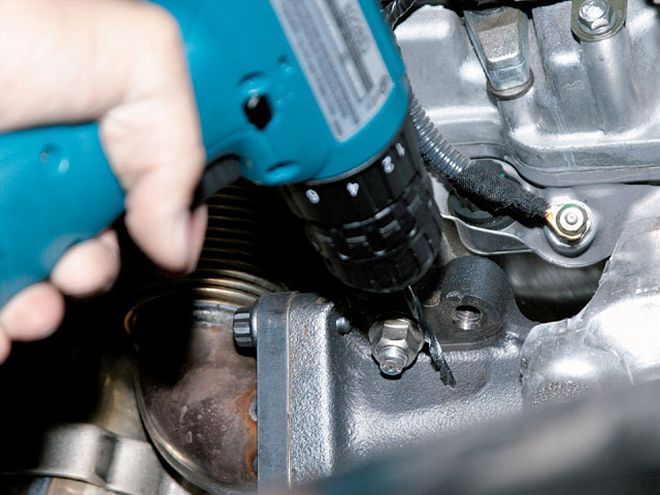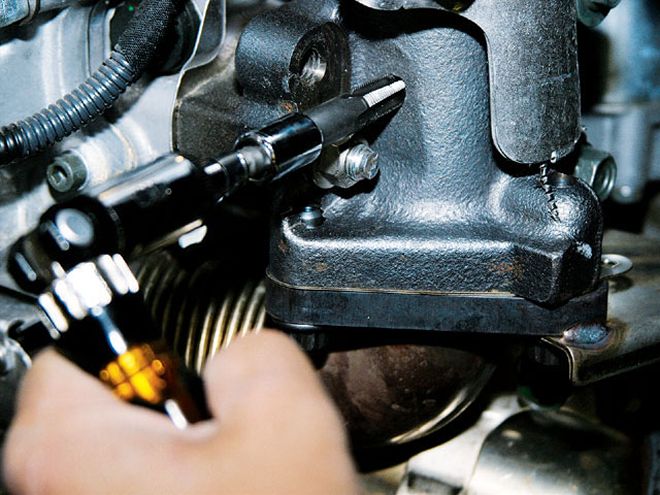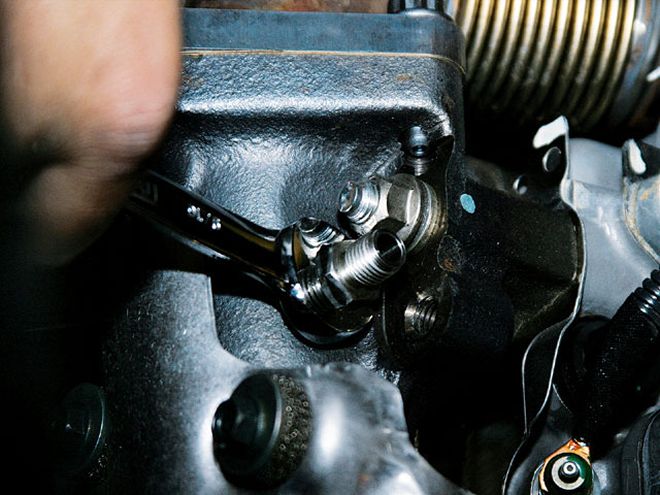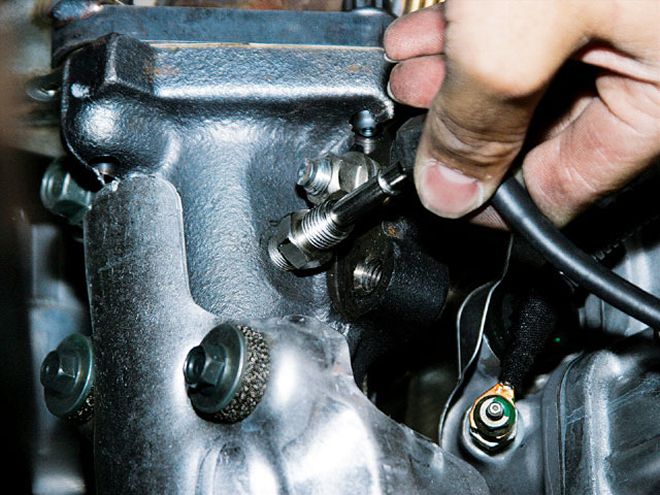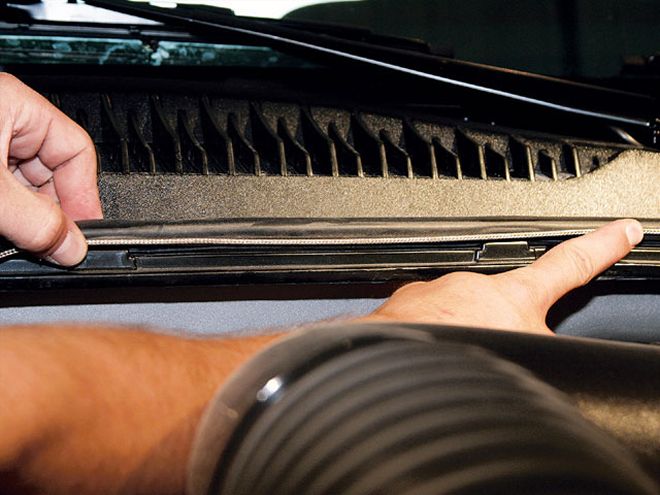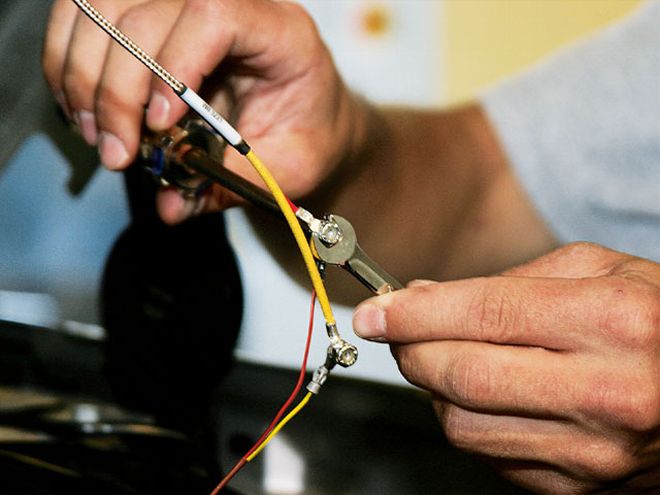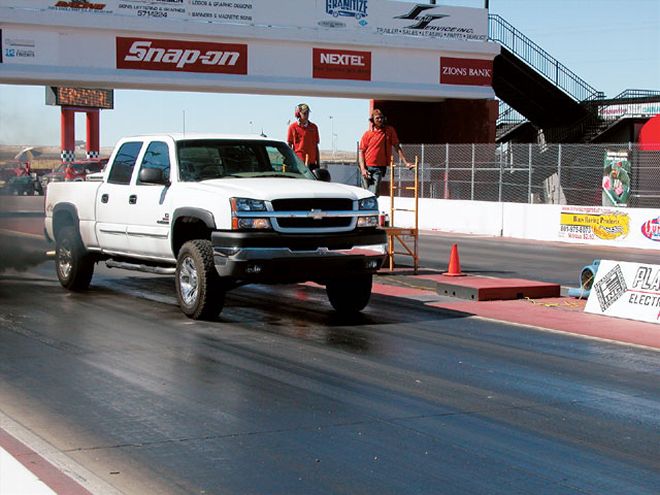
| edge Juice With Attitude white Chevy Truck
The concept of diesel performance used to be a contradiction. It often involved bolting an expensive aftermarket turbo system onto a heavy truck barely capable of getting out of its own black cloud. GM's 6.2L diesel was notorious for its unspectacular power-to-weight ratio, and the 6.5L version famous for powering the military Humvee was marginally better.
GM finally entered the light-duty diesel market for the 2000 model-year with its 6.6L Duramax, developed with Isuzu. The aftermarket finally had a GM oil-burner worth hot-rodding. Thanks to computer-controlled engine management, huge performance gains of 50 percent or more could be achieved by hijacking the factory software. Aftermarket hard parts such as freer-flowing exhausts still have their place, but electronic programmers and engine modules really pump up the power by changing the fuel-injector pulse to squirt more fuel, then tuning the combustion timing and turbo boost to burn the extra fuel.
That's good and bad. Obviously, a lot more fuel and significantly extra air equals major power improvements. But, there are pitfalls: More power generates more heat, and the factory gear train was engineered to work with stock engine output. So, the diesel aftermarket's primary challenge isn't just making power but instead involves using as many of the vehicle's PCM (powertrain control module) signals to reliably get the power to the ground.
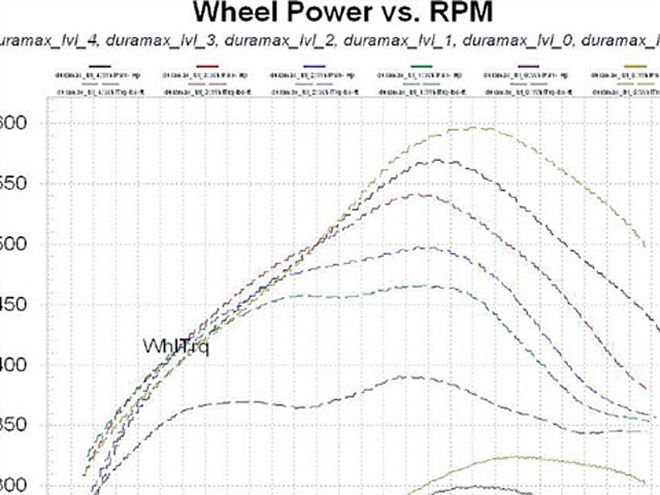
| On a stock LLY-series '04 Silverado diesel, Edge's SuperFlow dyno documented baseline numbers of 209 hp/390 lb-ft. Level 1 added 35 hp/76 lb-ft (244/466); Level 2 increased by 51 hp/108 lb-ft (260/498) over stock; Level 3 made 71 hp/150 lb-ft (280/540); Level 4 added 91 hp/180 lb-ft (300/570); and Level 5 topped out at 116 hp/206 lb-ft (325/596) on this truck. Edge's LB7 Duramax system offers similar gains.
Several diesel power systems are currently on the market. In general, their price reflects the amount of engineering that goes into the product. Some lower-end systems increase fueling to make power but don't address other powertrain parameters. Depending on usage, these lower-priced systems might work well when used in conjunction with aftermarket gauges for a driver who constantly monitors his engine's vitals.
On the other end of the spectrum are fully featured systems that control automatic transmission functions, in addition to adding more fuel, boost, and timing. The Edge Juice With Attitude is an example of one of these higher-end systems currently available for the Duramax. Built-in features, such as gauge-like engine and transmission monitoring on a digital display and automated safeguards that hold back fuel under danger-zone conditions, reflect the level of engineering expertise behind the product.
Under the HoodEdge's Juice power module plugs into factory sensors in the engine compartment. This allows the Juice to intercept signals between the truck's PCM and the engine, constantly optimizing fueling and timing in real time, based on the selected power level. The Juice offers four levels, maxing out at 90 hp/200 lb-ft, and adding Edge's optional Attitude monitor/controller yields an extra power level in addition to on-the-fly level-changing capability and a host of other features detailed below. For those who don't choose to step up to the Attitude-and who do any diesel performance modification-Edge recommends adding a complete set of aftermarket gauges for powertrain monitoring.
Edge also offers a competition-only Hot Juice With Attitude that adds 150 hp/350 lb-ft of torque. It has an even more aggressive fuel curve than the regular Juice and is engineered for trucks that have extensive aftermarket modifications, including cold-air systems, oversized turbos, free-flowing exhausts, and built transmissions. An '01-'04 LB7 Hot Juice has been available for awhile, and an LLY system is scheduled for release around press time.
Monitoring/ControllingFor less than the cost of aftermarket pyrometer (EGT), boost, and tranny temperature gauges and their respective pods/mounts, Edge offers its optional Attitude monitor/power controller. It uses a backlit LCD screen to display a variety of powertrain-related information. The driver can select any two parameters to show as bar graphs or as many as four powertrain functions to monitor digitally, including Turbo Boost, EGT, actual speed (corrected for non-stock tire diameters), throttle position, engine rpm, torque converter clutch status, engine load, transmission clutch slippage, and current gear backdown due to high EGT.
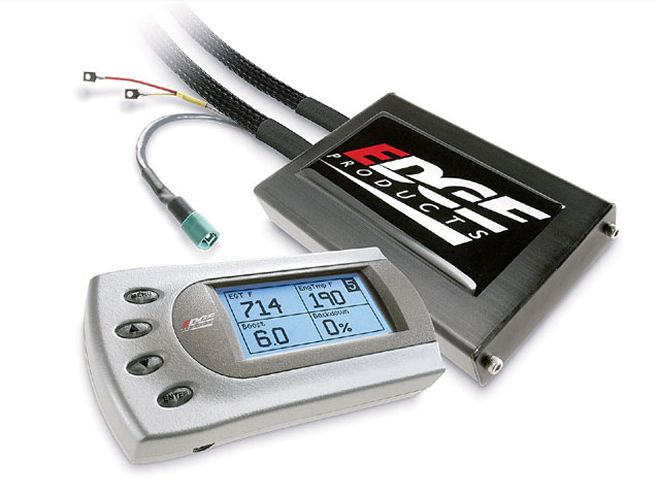
| edge Juice With Attitude edge Products
Edge's Juice With Attitude kit includes the Juice power module, which has built-in wiring leads for the Attitude monitor/controller, an Attitude mounting arm, and an EGT thermocouple (not shown). The new A2 Attitude with a color monitor, a GPS navigation, and a wireless back-up camera should be available by press time.
Then, the Attitude goes a step further, adding safeguards and warnings, so that the driver can concentrate on the road instead of on the powertrain functions. For starters, the Edge system doesn't modify fuel or timing while the engine temperature is below 160 degrees Fahrenheit. At 160 degrees Fahrenheit, the Juice module begins delivering fuel at as much as 50 percent of the calculated additional fuel available. The fueling percentage increases as the engine warms up, and the Juice With Attitude begins delivering 100 percent of the calculated additional fuel and begins to modify timing once the engine reaches 174 degrees Fahrenheit.
The Attitude also features four safeguards and alerts. First and foremost, Edge pre-sets the EGT limit at 1,350 degrees Fahrenheit. However, the user can reprogram the Attitude for a different temperature and also specify how many minutes to enable defueling/EGT backdown. During defueling, the backdown percentage is displayed on the monitor with user-defeatable warning sounds.
Other alert parameters can be reprogrammed or turned off individually by the user. These are boost (25.0 psi default), speed (70 mph default), and engine temp (210 degrees Fahrenheit default).
The Attitude also features a Low Boost Fueling Adjustment. This provides five off-the-line smoke-control levels within each power level. Sublevel 1 emits the least smoke and is CARB-friendly; Sublevel 5 is the most responsive but belches the most smoke.
Transmission LifeThe aftermarket can make such impressive gains in diesels because the OEs don't tap their engines' full potentials and powertrain warranties dictate a conservative approach. Edge and others have discovered that making power in Duramaxes is less a function of how much fuel, boost, and timing to add and more the art of reliably getting the power to the ground.
So, the Allison transmission must be addressed in order to transfer torque smoothly. Edge's Juice-Attitude monitors the torque converter and automatically defuel when slippage is detected. The user can disable the defueling feature (likely increasing transmission wear), or apply backdown to all locked shifts or only to four to five locked shifts. The percentage of torque converter and tranny clutch slippage is displayed on the Attitude's screen. Once the unit is installed, the truck's Duramax PCM takes about 150 miles to "learn" shifting points for the Edge engine-optimizing software.
"Level"-ing the Playing FieldThe Edge Juice With Attitude offers five levels for a reason: to match necessary power with specific driving conditions. Towing is the most critical: Edge recommends that the tranny always be put in Tow/Haul mode to provide torque converter lockup in gears from Second to Fifth, reducing transmission heat. This also raises the shift rpm threshold; Edge recommends maintaining engine rpm above 1,800 whenever possible while towing.
Edge-increased power also minimizes shifting while towing: The Duramax is able to maintain a higher gear longer, so gear hunting is reduced. This helps maximize fuel economy, too.
Here Are Edge's Power-Level Guidelines:Level 1 (40 hp/100 lb-ft): For increasing fuel economy and for towing heavy trailers. (For towing loads more than 14,000 pounds GVW on grades steeper than 6 percent, Edge recommends switching to stock power.)
Level 2 (60 hp/120 lb-ft): For increasing fuel economy and for towing trailers weighing less than 6,000 pounds.
Level 3 (75 hp/170 lb-ft): Not recommended for towing but improves overall driveability and performance.
Level 4 (90 hp/200 lb-ft): Not recommended for towing, it helps maximize other aftermarket upgrades, such as a cold-air intake and a performance exhaust system. It can overstress the engine and transmission over prolonged periods.
Level 5 (125 hp/240 lb-ft): Competition level to be used with other engine enhancements, such as modified fuel injectors and non-factory turbos. It can overstress the engine and transmission over prolonged periods.
Finally, the Attitude can record and store Duramax performance and engine information. Edge uses the vehicle's speed sensor data to capture 0-60 mph and quarter-mile acceleration times (seconds and top speed). The Attitude can also be programmed for non-stock tire diameters to show actual road speed. The maximum values that the Attitude can store are engine temperature, backdown percentage, rpm, and top speed.
The upside of this is that the diesel aftermarket offers enormous power possibilities for owners of computer-controlled oil-burners. Although Duramaxes are relative newcomers to the diesel hot-rodding scene, aftermarket specialists are giving them the same attention as Cummins and Power Strokes.
 | edge Juice With Attitude white Chevy Truck
The concept of diesel performance used to be a contradiction. It often involved bolting an expensive aftermarket turbo system onto a heavy truck barely capable of getting out of its own black cloud. GM's 6.2L diesel was notorious for its unspectacular power-to-weight ratio, and the 6.5L version famous for powering the military Humvee was marginally better.
GM finally entered the light-duty diesel market for the 2000 model-year with its 6.6L Duramax, developed with Isuzu. The aftermarket finally had a GM oil-burner worth hot-rodding. Thanks to computer-controlled engine management, huge performance gains of 50 percent or more could be achieved by hijacking the factory software. Aftermarket hard parts such as freer-flowing exhausts still have their place, but electronic programmers and engine modules really pump up the power by changing the fuel-injector pulse to squirt more fuel, then tuning the combustion timing and turbo boost to burn the extra fuel.
That's good and bad. Obviously, a lot more fuel and significantly extra air equals major power improvements. But, there are pitfalls: More power generates more heat, and the factory gear train was engineered to work with stock engine output. So, the diesel aftermarket's primary challenge isn't just making power but instead involves using as many of the vehicle's PCM (powertrain control module) signals to reliably get the power to the ground.
| edge Juice With Attitude white Chevy Truck
The concept of diesel performance used to be a contradiction. It often involved bolting an expensive aftermarket turbo system onto a heavy truck barely capable of getting out of its own black cloud. GM's 6.2L diesel was notorious for its unspectacular power-to-weight ratio, and the 6.5L version famous for powering the military Humvee was marginally better.
GM finally entered the light-duty diesel market for the 2000 model-year with its 6.6L Duramax, developed with Isuzu. The aftermarket finally had a GM oil-burner worth hot-rodding. Thanks to computer-controlled engine management, huge performance gains of 50 percent or more could be achieved by hijacking the factory software. Aftermarket hard parts such as freer-flowing exhausts still have their place, but electronic programmers and engine modules really pump up the power by changing the fuel-injector pulse to squirt more fuel, then tuning the combustion timing and turbo boost to burn the extra fuel.
That's good and bad. Obviously, a lot more fuel and significantly extra air equals major power improvements. But, there are pitfalls: More power generates more heat, and the factory gear train was engineered to work with stock engine output. So, the diesel aftermarket's primary challenge isn't just making power but instead involves using as many of the vehicle's PCM (powertrain control module) signals to reliably get the power to the ground.
 | On a stock LLY-series '04 Silverado diesel, Edge's SuperFlow dyno documented baseline numbers of 209 hp/390 lb-ft. Level 1 added 35 hp/76 lb-ft (244/466); Level 2 increased by 51 hp/108 lb-ft (260/498) over stock; Level 3 made 71 hp/150 lb-ft (280/540); Level 4 added 91 hp/180 lb-ft (300/570); and Level 5 topped out at 116 hp/206 lb-ft (325/596) on this truck. Edge's LB7 Duramax system offers similar gains.
Several diesel power systems are currently on the market. In general, their price reflects the amount of engineering that goes into the product. Some lower-end systems increase fueling to make power but don't address other powertrain parameters. Depending on usage, these lower-priced systems might work well when used in conjunction with aftermarket gauges for a driver who constantly monitors his engine's vitals.
On the other end of the spectrum are fully featured systems that control automatic transmission functions, in addition to adding more fuel, boost, and timing. The Edge Juice With Attitude is an example of one of these higher-end systems currently available for the Duramax. Built-in features, such as gauge-like engine and transmission monitoring on a digital display and automated safeguards that hold back fuel under danger-zone conditions, reflect the level of engineering expertise behind the product.
Under the Hood
| On a stock LLY-series '04 Silverado diesel, Edge's SuperFlow dyno documented baseline numbers of 209 hp/390 lb-ft. Level 1 added 35 hp/76 lb-ft (244/466); Level 2 increased by 51 hp/108 lb-ft (260/498) over stock; Level 3 made 71 hp/150 lb-ft (280/540); Level 4 added 91 hp/180 lb-ft (300/570); and Level 5 topped out at 116 hp/206 lb-ft (325/596) on this truck. Edge's LB7 Duramax system offers similar gains.
Several diesel power systems are currently on the market. In general, their price reflects the amount of engineering that goes into the product. Some lower-end systems increase fueling to make power but don't address other powertrain parameters. Depending on usage, these lower-priced systems might work well when used in conjunction with aftermarket gauges for a driver who constantly monitors his engine's vitals.
On the other end of the spectrum are fully featured systems that control automatic transmission functions, in addition to adding more fuel, boost, and timing. The Edge Juice With Attitude is an example of one of these higher-end systems currently available for the Duramax. Built-in features, such as gauge-like engine and transmission monitoring on a digital display and automated safeguards that hold back fuel under danger-zone conditions, reflect the level of engineering expertise behind the product.
Under the Hood | edge Juice With Attitude edge Products
Edge's Juice With Attitude kit includes the Juice power module, which has built-in wiring leads for the Attitude monitor/controller, an Attitude mounting arm, and an EGT thermocouple (not shown). The new A2 Attitude with a color monitor, a GPS navigation, and a wireless back-up camera should be available by press time.
Then, the Attitude goes a step further, adding safeguards and warnings, so that the driver can concentrate on the road instead of on the powertrain functions. For starters, the Edge system doesn't modify fuel or timing while the engine temperature is below 160 degrees Fahrenheit. At 160 degrees Fahrenheit, the Juice module begins delivering fuel at as much as 50 percent of the calculated additional fuel available. The fueling percentage increases as the engine warms up, and the Juice With Attitude begins delivering 100 percent of the calculated additional fuel and begins to modify timing once the engine reaches 174 degrees Fahrenheit.
The Attitude also features four safeguards and alerts. First and foremost, Edge pre-sets the EGT limit at 1,350 degrees Fahrenheit. However, the user can reprogram the Attitude for a different temperature and also specify how many minutes to enable defueling/EGT backdown. During defueling, the backdown percentage is displayed on the monitor with user-defeatable warning sounds.
Other alert parameters can be reprogrammed or turned off individually by the user. These are boost (25.0 psi default), speed (70 mph default), and engine temp (210 degrees Fahrenheit default).
The Attitude also features a Low Boost Fueling Adjustment. This provides five off-the-line smoke-control levels within each power level. Sublevel 1 emits the least smoke and is CARB-friendly; Sublevel 5 is the most responsive but belches the most smoke.
Transmission Life
| edge Juice With Attitude edge Products
Edge's Juice With Attitude kit includes the Juice power module, which has built-in wiring leads for the Attitude monitor/controller, an Attitude mounting arm, and an EGT thermocouple (not shown). The new A2 Attitude with a color monitor, a GPS navigation, and a wireless back-up camera should be available by press time.
Then, the Attitude goes a step further, adding safeguards and warnings, so that the driver can concentrate on the road instead of on the powertrain functions. For starters, the Edge system doesn't modify fuel or timing while the engine temperature is below 160 degrees Fahrenheit. At 160 degrees Fahrenheit, the Juice module begins delivering fuel at as much as 50 percent of the calculated additional fuel available. The fueling percentage increases as the engine warms up, and the Juice With Attitude begins delivering 100 percent of the calculated additional fuel and begins to modify timing once the engine reaches 174 degrees Fahrenheit.
The Attitude also features four safeguards and alerts. First and foremost, Edge pre-sets the EGT limit at 1,350 degrees Fahrenheit. However, the user can reprogram the Attitude for a different temperature and also specify how many minutes to enable defueling/EGT backdown. During defueling, the backdown percentage is displayed on the monitor with user-defeatable warning sounds.
Other alert parameters can be reprogrammed or turned off individually by the user. These are boost (25.0 psi default), speed (70 mph default), and engine temp (210 degrees Fahrenheit default).
The Attitude also features a Low Boost Fueling Adjustment. This provides five off-the-line smoke-control levels within each power level. Sublevel 1 emits the least smoke and is CARB-friendly; Sublevel 5 is the most responsive but belches the most smoke.
Transmission Life